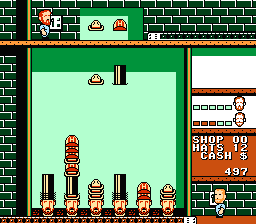Overview
Hatris is a falling-block tile-matching puzzle game developed and published by Bullet-Proof Software for the Family Computer in Japan in 1990.
Designed by Alexey Pajhitnov and Vladimir Pokhilko (the former previously known for Tetris, Welltris, and Faces) from the company ParaGraph, Hatris has players managing six stacks of hats by controlling new sets of hats falling from the top of the screen in pairs (swapping them horizontally using a button).
The objective is to form vertical stacks of five-or-more consecutive hats of the same type, of which there are six in total, and remove as much of them from the board as possible before a stack reaches the upward end line. Unique to this game is how pieces are stacked according to their height and brim size, with the bottom hat being partially obstructed by the top hat. Some hats are tall, but have a very short brims (such as top hats), while some are short but have very large brims (such as crowns).
The game also received ports in 1990-1991 for the arcade, 8000- and 9000-series Sharp Wizard organizers, the PC Engine, the Game Boy, and the NEC PC-9801. The arcade version was ported by Video System, while the Sharp Wizard and PC Engine ports were handled by Micro Cabin. The arcade, Sharp Wizard, and Game Boy ports were also released overseas. An enhanced version of the Famicom version was released in 1992 for the Nintendo Entertainment System overseas.
Each of the ports have their own unique gameplay changes, such as changing each hat size and score, changing the size of the "end line", modifying the "Sale" system (with the NES version replacing them with the "Helper" system), and adding special "Fire" pieces (which burn a stack of same-type hats).
Gameplay

At the bottom of the screen are six male (sometimes female) heads. Pairs of hats fall from the top of the screen, and the player has to stack the hats on top of the men's heads. Once five of the same type of hat are stacked on top of each other, that stack is cleared and the player is awarded points.
In some versions of the game super deformed avatars of Pajhitnov and Pokhilko appear in the game as characters who assist the player in removing hats and rearranging stacks of hats.
Hats
Arcade
Score multiplier increases every 5 sets.
- Helmet (20 pt. base) - 8 pixels tall (4 px. brim).
- Bowler (40 pt. base) - 12 pixels tall (4 px. brim).
- Sombrero (50 pt. base) - 12 pixels tall (8 px. brim).
- Top Hat (100 pt. base) - 20 pixels tall (4 px. brim).
- Sorceror's Hat (150 pt. base) - 28 pixels tall (8 px. brim). First appears after 10 sets cleared.
- Crown (200 pt. base) - 16 pixels tall (12 px. brim). First appears after 15 sets cleared.
Famicom, NES, Sharp Wizard, Game Boy, and PC-9801
- Derby (50 pts.) - 8 pixels tall (2 px. brim). Beanie in the GB version.
- Cowboy Hat (80 pts.) - 11 pixels tall (5 px. brim). Mountaineering Hat in the Famicom and Sharp versions.
- Baseball Cap (120 pts.) - 12 pixels tall (6 px. brim). Cowboy Hat in the Famicom and Sharp versions. Sombrero in the GB and PC-9801 versions.
- Top Hat (150 pts.) - 20 pixels tall (2 px. brim). Generally does not appear until a bit of time has passed.
- Wizard Hat (200 pts.) - 24 pixels tall (4 px. brim). Generally does not appear until later.
- Crown (300 pts.) - 16 pixels tall (10 px. brim). Generally does not appear until much later.
PC Engine
- Bowler Hat (50 pt. base)
- Mountaineering Hat (80 pt. base)
- Umbrella Cap (120 pt. base)
- Top Hat (150 pt. base) - First appears in Stage 2.
- Pointed Hat (200 pt. base) - First appears in Stage 4.
- Crown (300 pt. base) - First appears in Stage 7.
Log in to comment